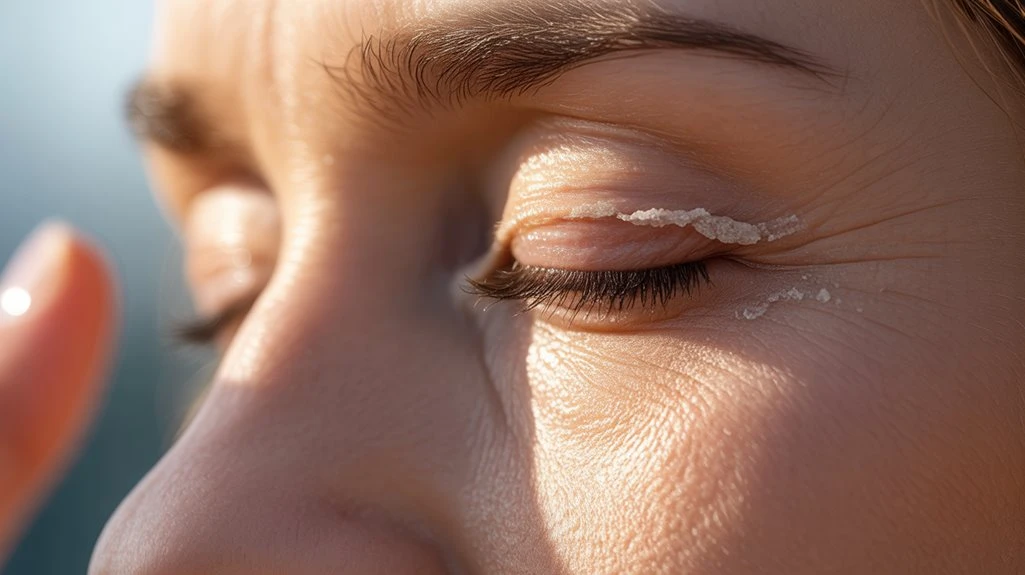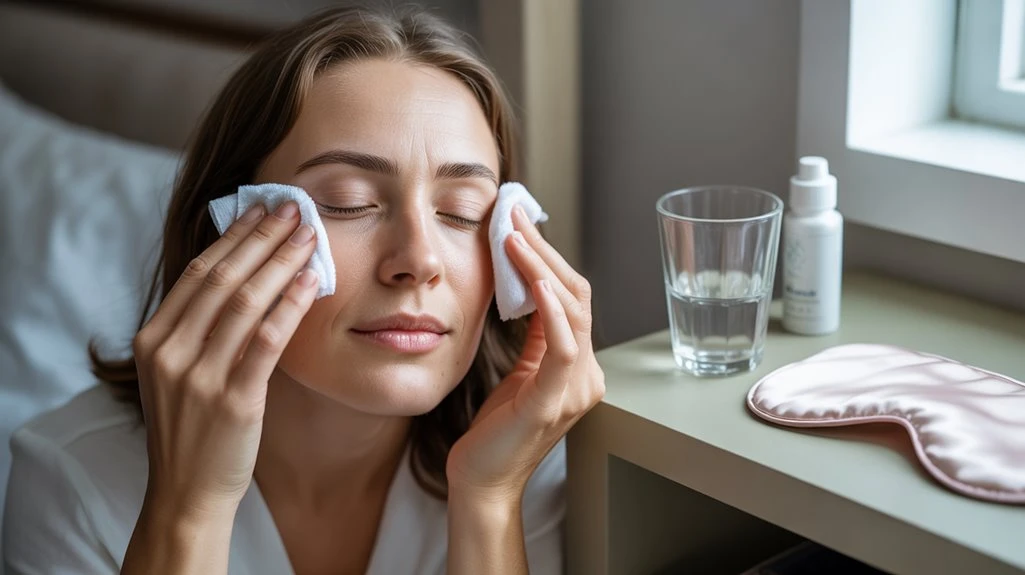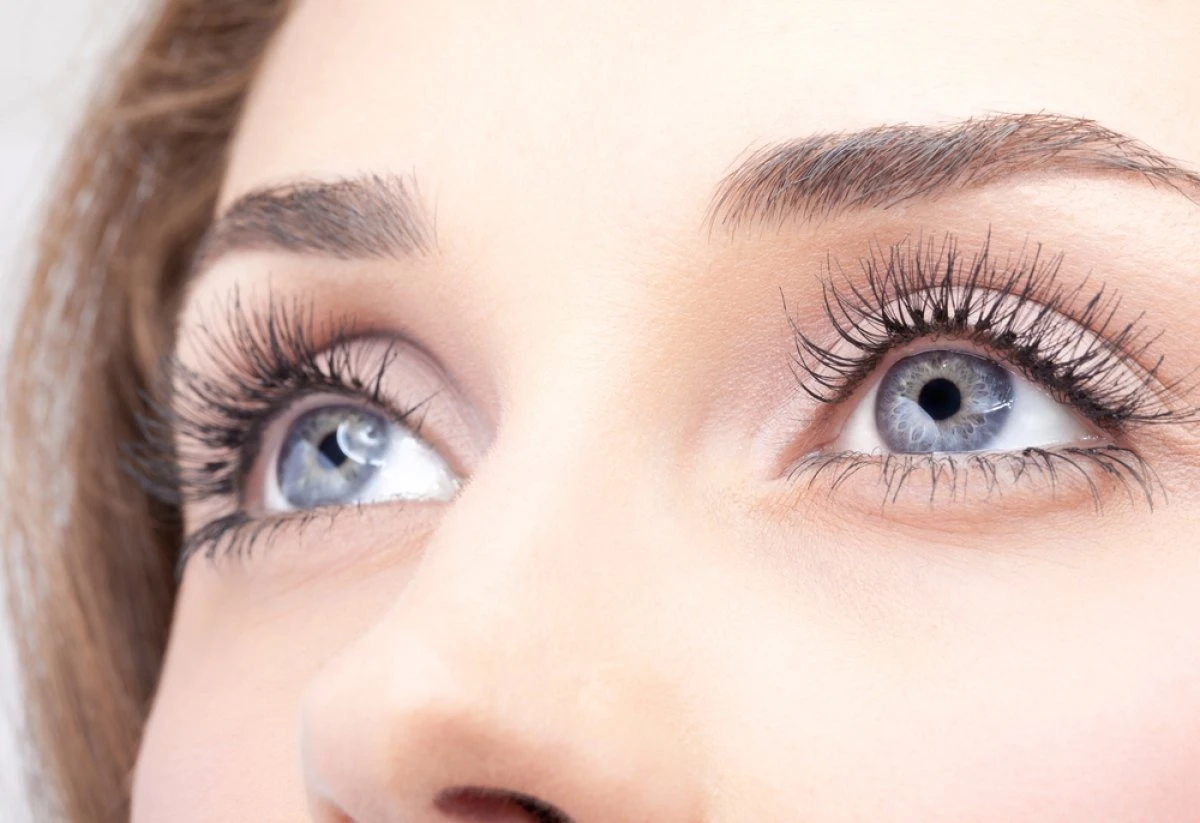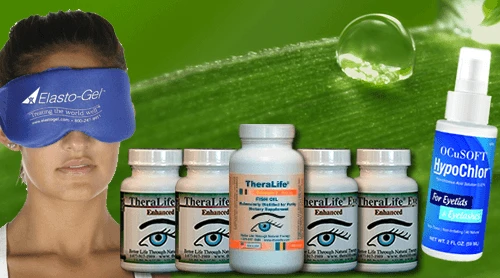You wake up with crusty eyes because, during sleep, your eyes naturally secrete mucus, oils, and debris that aren’t cleared by blinking. This buildup is usually harmless, but excessive or sticky discharge may suggest dry eye, allergic conjunctivitis, or even an eye infection. If you use contact lenses or sleep in a dry or dusty environment, you’re more likely to notice morning crust.
TheraLife offers a unique solution to this issue as the only company providing oral eye treatment care. Their products are designed to improve eye health from within, addressing the root causes of dry eye and other related conditions. By using TheraLife‘s products, you can experience relief from symptoms like crusty eyes in the morning. Proper eye hygiene and TheraLife’s innovative treatment can help you maintain eye health and comfort.
Get Rid Of Crusty Eyes – Treat Your Dry Eyes With TheraLife
Add To Cart
Key Takeaways
- Overnight, natural eye secretions like mucus and oils accumulate because blinking stops, leading to morning crustiness.
- Allergies or exposure to dust mites and pillow allergens can increase eye discharge and crust formation.
- Dry eye syndrome or low humidity can reduce lubrication, causing more debris to build up overnight.
- Thick, colored, or excessive discharge may signal eye infections and should prompt medical attention.
- Good eyelid hygiene and using warm compresses can help reduce morning eye crust and irritation.
What Causes Morning Crusty Eyes?

Although waking up with crusty eyes is common, it’s primarily due to the overnight accumulation of ocular secretions, including mucus, oil, skin cells, and environmental debris.
Your sleep positions greatly influence this process. For example, sleeping face down or on your side can increase direct contact between your eyelids and pillow materials, potentially introducing additional irritants or allergens.
Certain pillow materials, such as feathers or synthetic fibers, may harbor dust mites or promote exposure to allergens, exacerbating periocular debris.
Evidence suggests that environmental particulates and allergens transferred from pillows can contribute to morning eye crust formation.
Blocked tear ducts can also lead to constant watery eyes, which may contribute to increased crust formation overnight.
Diagnostic evaluation should assess both your habitual sleep positions and the composition and cleanliness of your pillow materials to identify modifiable risk factors for excessive crusting and associated ocular irritation upon awakening.
The Role of Natural Eye Secretions
Natural eye secretions, primarily composed of mucins, lipids, and aqueous components, play an essential role in maintaining ocular surface homeostasis. You produce these layers continuously, ensuring natural lubrication, tear film stability, and protection from environmental insults.
During sleep, blink-induced tear clearance halts, causing secretions—especially mucins and lipids—to accumulate at the eyelid margins. This residue, often termed rheum, is a normal byproduct of your eye’s self-cleaning mechanisms. It traps debris and microbial particles, supporting eye health by minimizing infection risk.
Upon waking, you’ll notice this crusty accumulation, which typically resolves with gentle cleansing. If increased eye crust is observed, it may signal underlying issues that require consultation with an ophthalmic professional to rule out ocular surface disorders affecting natural lubrication and tear film function. If you observe excessive or abnormal discharge, persistent irritation, or visual changes, it’s advisable to consult an ophthalmic professional to rule out underlying ocular surface disorders affecting natural lubrication and tear film function.
Allergies and Eye Discharge – In Crusty Eyes
When your immune system reacts to airborne allergens such as pollen, pet dander, or dust mites, it often triggers an inflammatory response in the conjunctiva, known as allergic conjunctivitis. This condition leads to hallmark allergy symptoms including pruritus, erythema, and increased lacrimation. You may notice a stringy, white mucous discharge, particularly on waking, which contributes to the crusting around your eyelids. During sleep, decreased blinking allows these secretions to accumulate, making the morning crustiness more pronounced. Eye discharge forms as a protective mechanism to remove toxins from eye tissues, and can vary in texture and color, signaling different conditions. Accurate diagnosis involves correlating subjective symptoms with clinical findings such as chemosis or papillary hypertrophy on slit-lamp examination. Effective eye care includes allergen avoidance, topical antihistamines, and, when needed, mast cell stabilizers. If you experience persistent or severe symptoms, consult an eye care professional for targeted management.
Dry Eye Syndrome and Overnight Crusting- In Crusty Eyes

You may experience overnight crusting if your tear production decreases during sleep, leading to inadequate ocular surface lubrication. Impaired eyelid closure or suboptimal eyelid hygiene can further exacerbate debris accumulation. Environmental factors like low humidity or exposure to irritants also greatly contribute to dry eye symptoms and morning discharge. Severe dry eyes can lead to complications like blepharitis and corneal abrasions.
Tear Production at Night
During sleep, your body’s nocturnal tear production markedly decreases. This hyposecretion, combined with complete eyelid closure, limits natural ocular surface lubrication and clearance of cellular debris.
If you have dry eye syndrome, this process intensifies overnight, leaving your eyes vulnerable to increased crusting upon waking.
You may experience:
- Greater dryness due to reduced nocturnal tear flow
- Accumulation of mucus and epithelial cells overnight
- Heightened irritation when you first open your eyes
- Discomfort that signals possible meibomian gland dysfunction
Evidence-based studies confirm that decreased overnight tear secretion, especially in individuals with underlying tear film instability, exacerbates morning crusting. TheraLife Eye capsules address the root cause of dry eyes by improving natural tear production, potentially reducing morning crusting.
Recognizing these nocturnal patterns is essential for accurate diagnosis and targeted management of dry eye symptoms.
Eyelid Function and Hygiene
Although nocturnal tear production diminishes, effective eyelid function remains essential for ocular surface protection and debris removal. Your eyelid anatomy plays a crucial role: the meibomian glands secrete lipids that limit tear evaporation, while the lid margin acts as a barrier against pathogens. Dysfunction in these structures, particularly in dry eye syndrome, can lead to excessive overnight crusting due to incomplete debris clearance. Clinical studies highlight that compromised eyelid hygiene practices—such as infrequent lid scrubs or poor removal of ocular secretions—exacerbate the accumulation of crusty deposits. Maintaining bedroom humidity at 40% or higher aids tear production, with the use of a hygrometer to monitor indoor humidity levels.
| Eyelid Anatomy | Function | Clinical Relevance |
|---|---|---|
| Meibomian Glands | Lipid secretion | Tear film stability |
| Lid Margin | Barrier formation | Blocks pathogens |
| Lash Follicles | Trap debris | Prevents irritation |
| Tarsal Plate | Structural support | Eyelid closure |
| Conjunctival Surface | Mucus production | Debris removal |
Role of Environmental Factors
When ambient humidity drops or exposure to airborne irritants increases, ocular surface homeostasis becomes disrupted, predisposing individuals to dry eye syndrome and nocturnal crusting. You may notice increased morning crusting when humidity levels are low or environmental pollutants are prevalent, as these conditions impair tear film stability and promote rapid evaporation. Overnight, reduced blink frequency and compromised tear production exacerbate desiccation, leading to accumulation of debris and mucus at the eyelid margins. Consider the following possible environmental triggers: 1. Low indoor or outdoor humidity levels, especially in winter or with air conditioning. 2. Persistent exposure to environmental pollutants such as smoke, dust, or chemicals. 3. Sleeping with a fan or heater directed toward your face. 4. Urban living with high particulate matter in the air. Artificial Tears, which provide temporary relief, can be used to help mitigate these symptoms by stabilizing the tear film and improving moisture retention. Identifying these factors guides targeted interventions.
Signs of Eye Infections to Watch For- In Crusty Eyes
You should monitor for persistent redness or swelling, as these symptoms often indicate an underlying eye infection. Pay attention to any unusual eye discharge, especially if it’s thick, colored, or increases in volume. Prompt recognition of these findings supports early diagnosis and appropriate intervention. It’s crucial to maintain proper eye hygiene to prevent complications and support overall eye health.
Persistent Redness or Swelling
Persistent redness or swelling of the eyes often signals an underlying infection such as conjunctivitis, blepharitis, or a more serious ocular condition. When you notice these symptoms, especially alongside persistent irritation or eyelid inflammation, it’s important to recognize that your ocular surface could be compromised. Clinical evidence shows that ongoing redness and swelling aren’t typical responses to minor environmental irritants, but rather suggest an active pathological process. Inflammatory cytokines such as IL-1beta and TNF-alpha are often involved in these ocular inflammatory conditions. You should remain vigilant for the following warning signs:
- Redness that doesn’t resolve after several days.
- Noticeable swelling of the eyelids or surrounding tissue.
- Persistent irritation that interferes with daily activities.
- Eyelid inflammation accompanied by pain or tenderness.
Prompt evaluation is essential; these signs may indicate conditions requiring medical intervention to prevent complications affecting vision and ocular health.
Unusual Eye Discharge In Crusty Eyes
Although mild crusting upon waking is common, the presence of unusual eye discharge—such as thick, yellow-green pus or copious, sticky secretions—often indicates an active ocular infection. You should be alert to changes in discharge consistency, color, or volume, as these may signal bacterial conjunctivitis or other infectious processes. Poor eye hygiene and certain sleep positions that cause incomplete eyelid closure can exacerbate discharge accumulation overnight. Evaluate the characteristics below to differentiate normal from pathological findings:
| Symptom | Diagnostic Implication |
|---|---|
| Thin, clear discharge | Usually benign, allergy-related |
| Thick, yellow-green pus | Suggests bacterial infection |
| Stringy, white discharge | May indicate viral conjunctivitis |
| Copious, sticky secretions | Points to severe infection |
| Unilateral presentation | Often bacterial or viral origin |
Practicing proper eyelid hygiene may help prevent infections that result in abnormal eye discharge. Seek prompt evaluation if you observe these signs, to initiate appropriate therapy and protect ocular health.
How Sleeping Habits Affect Eye Health – In Crusty Eyes
Because sleep quality and duration directly influence ocular surface health, disruptions in sleeping habits often manifest as increased eye irritation and discharge upon waking.
When you don’t get adequate restorative sleep, your eyes lack sufficient time for tear film regeneration and epithelial repair. This frequently results in increased crusting and discomfort.
Evidence-based studies highlight the importance of consistent sleep patterns for ideal eye relaxation and debris clearance. Poor sleep quality may exacerbate inflammatory responses, impair meibomian gland function, and destabilize the tear film, all of which contribute to morning crustiness.
Consider these diagnostic implications if your sleep is compromised:
- Increased risk of chronic eye irritation
- Heightened inflammatory response in ocular tissues
- Impaired tear production and distribution
- Reduced effectiveness of natural debris removal mechanisms
Prioritizing sleep quality directly benefits ocular surface health.
Contact Lenses and Increased Eye Discharge
If you wear contact lenses, improper lens hygiene can increase ocular discharge and promote microbial contamination.
Sleeping with contacts may cause overnight irritation, leading to inflammatory exudate and morning crusting.
It’s important to assess your lens care practices and overnight wear to identify contributing factors.
Lens Hygiene Impact
Proper lens hygiene plays a critical role in preventing increased eye discharge among contact lens users. Inadequate lens care can lead to bacterial colonization, protein deposits, and inflammatory reactions, all of which elevate the risk of morning crustiness.
Evidence links poor hygiene practices with conjunctivitis and meibomian gland dysfunction, both common culprits in excessive ocular secretions. If you neglect daily cleaning or wear lenses overnight, your risk grows considerably.
Consider the following diagnostic risks:
- Microbial keratitis: Bacterial or fungal infection from contaminated lenses.
- Allergic conjunctivitis: Protein or preservative buildup triggering inflammation.
- Giant papillary conjunctivitis: Chronic irritation from unclean lenses.
- Tear film instability: Disrupted tear composition due to poor lens hygiene.
Adhering to rigorous lens care and hygiene practices is essential for diagnostic prevention of eye discharge.
Overnight Irritation Effects
Although overnight contact lens wear may seem convenient, it greatly increases ocular surface irritation and morning eye discharge.
When you sleep with lenses in, you reduce oxygen permeability to the cornea, disrupting overnight hydration and encouraging inflammatory responses. This hypoxic environment stimulates the conjunctival and meibomian glands to overproduce mucus and oil, resulting in excessive crusting upon awakening.
Contact lens-associated overnight irritation also impairs the eyelid’s natural cleaning mechanism, trapping debris and microorganisms beneath the lens surface.
Evidence indicates that poor eyelid care, especially when wearing lenses overnight, elevates your risk of developing blepharitis or infectious conjunctivitis, both of which manifest as increased morning discharge.
To minimize these sequelae, adhere to recommended lens removal practices and prioritize thorough eyelid care before sleep to maintain ocular surface health.
When to Worry About Crusty Eyes
While most eye crust in the morning signals normal tear film turnover, certain characteristics warrant closer evaluation.
Maintaining eye health requires recognizing when crusty eyes might indicate an underlying pathology. If your morning discharge is persistent, excessive, or accompanied by other concerning symptoms, it’s wise to reflect on potential causes beyond routine debris.
Evidence-based guidelines suggest seeking medical assessment if you notice the following:
- Yellow or green discharge that’s thick, sticky, or foul-smelling
- Redness, swelling, or pain that persists beyond mild irritation
- Blurred vision or increased sensitivity to light
- Crusting that causes the eyelids to stick together upon waking
These findings may signal bacterial conjunctivitis, blepharitis, or other ocular surface disorders.
Timely diagnosis guarantees ideal eye health and prevents complications associated with untreated crusty eyes.
Tips for Preventing Crusty Eyes

Monitoring for warning signs allows for early intervention, but adopting preventive strategies minimizes the occurrence of bothersome morning eye crust.
Prioritize thorough eye care by cleansing your eyelids daily using a gentle, non-irritating cleanser to remove debris and reduce the risk of meibomian gland dysfunction.
Avoid touching or rubbing your eyes to decrease bacterial transmission and potential inflammation.
Maintain ideal sleep hygiene by ensuring you get sufficient, uninterrupted sleep, which promotes ocular surface repair and limits nocturnal tear film instability.
Use clean pillowcases and avoid sleeping with eye makeup to further reduce irritant exposure.
If you wear contact lenses, adhere strictly to recommended lens hygiene protocols.
These evidence-based measures can decrease the incidence of crusty eyes and support overall ocular health, minimizing unwanted morning symptoms.
Home Remedies and Treatment Options
If you notice recurrent crusty eyes upon waking, prompt implementation of targeted home care can alleviate symptoms and prevent complications.
Evidence-based approaches prioritize both eye care and sleep hygiene. Begin by cleansing your eyelids with a sterile saline solution or a gentle, preservative-free eyelid wipe to reduce microbial load and debris.
Warm compresses applied for 5–10 minutes can liquefy hardened secretions and facilitate their removal, promoting meibomian gland health.
Adjusting your sleep environment—such as using a humidifier—can reduce evaporative stress and promote ocular surface integrity.
Prioritize consistent sleep hygiene to minimize nocturnal irritation.
- Cleanse eyelids daily with sterile solutions
- Apply warm compresses for secretion clearance
- Optimize bedroom humidity
- Maintain regular, restorative sleep patterns
Early intervention supports ocular surface stability and prevents recurrence.
Get Rid Of Crusty Eyes – Treat Your Dry Eyes With TheraLife
Add To Cart
Frequently Asked Questions
Can Diet or Nutrition Affect Morning Eye Crust?
You should consider the hydration impact and potential vitamin deficiencies when evaluating morning ocular discharge.
Insufficient fluid intake can reduce tear production, leading to thicker secretions. Deficiencies in vitamins A, B2, and omega-3 fatty acids may disrupt normal tear film stability and conjunctival health, increasing crust formation.
Clinically, you’d benefit from examining dietary intake and hydration status as part of the diagnostic process to rule out nutritional contributions to your symptoms.
Do Pets Increase the Risk of Eye Crustiness?
If you have pets, you could experience increased eye crustiness due to pet allergies. Allergens like dander can trigger conjunctival inflammation, leading to excess mucus and debris.
Maintaining proper eye hygiene—such as washing your hands after handling pets and avoiding touching your eyes—can mitigate risk. If symptoms persist, consider diagnostic evaluation for allergic conjunctivitis.
Evidence shows that allergen exposure is a significant factor in ocular surface irritation and discharge.
Are Certain Medications Linked to Eye Discharge?
Certain medications can cause eye discharge as a result of medication side effects.
You might notice different eye discharge types, such as watery, mucous, or purulent secretions, depending on the drug involved.
Antihistamines, decongestants, and some ocular drops can decrease tear production, leading to irritation and secondary discharge.
Always inform your healthcare provider about new or worsening symptoms, so they can assess whether your medication regimen requires adjustment or further diagnostic evaluation.
Can Screen Time Before Bed Worsen Eye Crust?
Excessive screen time before bed exposes you to blue light, which research shows disrupts sleep quality by suppressing melatonin production.
Clinically, inadequate sleep may reduce tear film stability, leading to increased ocular surface irritation and overnight accumulation of mucous or crust.
If you frequently use digital devices at night, you may notice more eye discharge upon waking due to these combined effects.
Consider limiting screen exposure to improve ocular comfort and sleep hygiene.
Is Morning Eye Crust Related to Hormonal Changes?
Like Odysseus traversing unpredictable seas, your body faces hormonal fluctuations that can impact ocular health.
During phases such as puberty, menstruation, or menopause, these hormonal shifts may alter tear film composition and meibomian gland function. This can increase morning eye crust, especially if sleep quality is compromised.
Clinically, it’s essential to assess endocrine status and sleep patterns when diagnosing persistent ocular discharge, as both factors may underlie symptomatic presentations.
Get Rid Of Crusty Eyes – Treat Your Dry Eyes With TheraLife
Add To Cart
Conclusion
Waking up with crusty eyes is common due to your body’s natural tear film clearing debris. However, if you experience chronic morning discharge, it may be associated with conditions like blepharitis or dry eye syndrome. TheraLife, the only company offering oral eye treatment care, provides products that significantly benefit those suffering from these conditions. By addressing underlying issues and promoting good eyelid hygiene, TheraLife products help reduce discomfort and protect your ocular health. If symptoms persist, it’s essential to consult an eye care professional.
References
- 1.
- Shekhawat NS, Shtein RM, Blachley TS, Stein JD. Antibiotic Prescription Fills for Acute Conjunctivitis among Enrollees in a Large United States Managed Care Network. Ophthalmology. 2017 Aug;124(8):1099-1107. [PMC free article] [PubMed]
- 2.
- Smith AF, Waycaster C. Estimate of the direct and indirect annual cost of bacterial conjunctivitis in the United States. BMC Ophthalmol. 2009 Nov 25;9:13. [PMC free article] [PubMed]
- 3.
- 4.
- de Laet C, Dionisi-Vici C, Leonard JV, McKiernan P, Mitchell G, Monti L, de Baulny HO, Pintos-Morell G, Spiekerkötter U. Recommendations for the management of tyrosinaemia type 1. Orphanet J Rare Dis. 2013 Jan 11;8:8. [PMC free article] [PubMed]
- 5.
- Sati A, Sangwan VS, Basu S. Porphyria: varied ocular manifestations and management. BMJ Case Rep. 2013 May 22;2013 [PMC free article] [PubMed]
- 6.
- Azari AA, Barney NP. Conjunctivitis: a systematic review of diagnosis and treatment. JAMA. 2013 Oct 23;310(16):1721-9. [PMC free article] [PubMed]
- 7.
- 8.
- Shields T, Sloane PD. A comparison of eye problems in primary care and ophthalmology practices. Fam Med. 1991 Sep-Oct;23(7):544-6. [PubMed]
- 9.
- 10.
- Turaka K, Penne RB, Rapuano CJ, Ayres BD, Abazari A, Eagle RC, Hammersmith KM. Giant fornix syndrome: a case series. Ophthalmic Plast Reconstr Surg. 2012 Jan-Feb;28(1):4-6. [PubMed]





